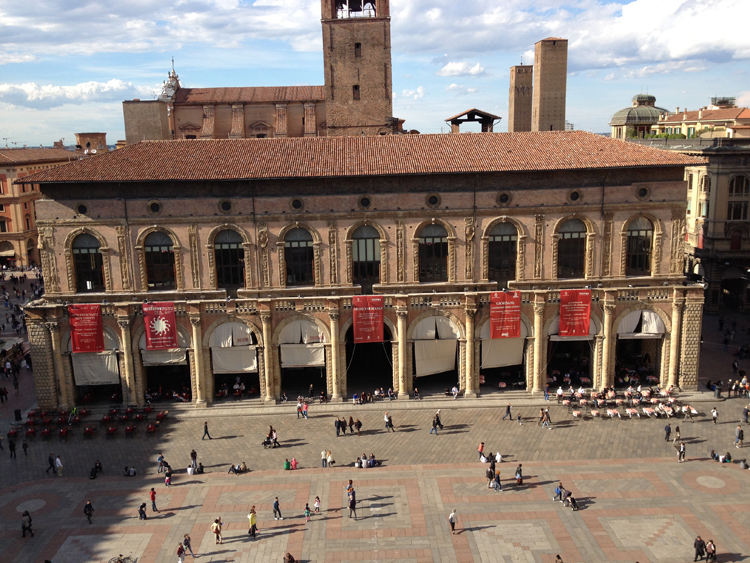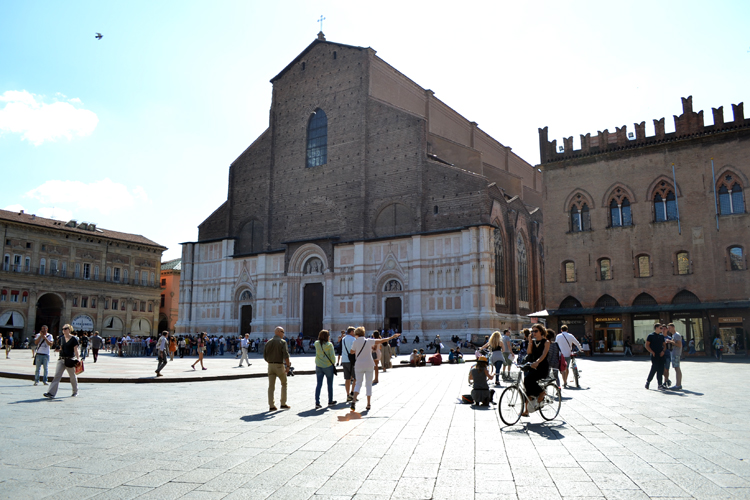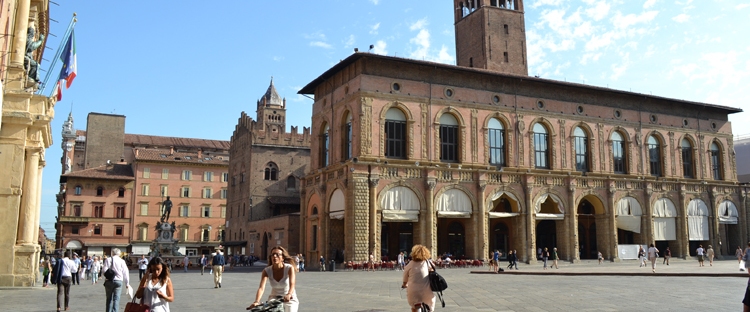Your exploration of Bologna should begin from Piazza Maggiore, the main square and the heart of town. Piazza Maggiore has been the center of Bologna’s political and social life since the 13th century when the square and the buildings surrounding it began being built.
It is one of the biggest and oldest squares in Italy. Here, citizens gathered to listen to the enunciation of new laws and to witness capital executions. The square was also home to one of Europe’s biggest open-air market until the mid-1800s, with goods coming from all parts of the world.

The buildings that surround the square are:
Palazzo D’Accursio in Bologna’s Piazza Maggiore
Above the entrance gate is the statue of Bologna native Pope Gregory XIII, blessing passers-by. The building had three courtyards: one was for receiving guests, one for storing weapons and one serving the prison. The old Cardinal apartments, the City Council Room, the Morandi Museum and the Farnese Chapel are located on the upper floors and accessed by a monumental staircase designed by Bramante.

Did you know? The Gregorian calendar, the international calendar in use today, takes its name from Pope Gregory XIII, who introduced it in 1582. It’s a solar calendar, which means that it is based on the cycle of the seasons.
Tip: Walk through the courtyard of Palazzo D’Accursio, and up the two staircases to reach the Sala Farnese for a great view of Piazza Maggiore from its windows.
*Entrance to Palazzo D’Accursio is free. Some rooms may be closed to the public if official functions are in place.
Palazzo del Podestà in Bologna’s Piazza Maggiore
Construction began in 1200 together with Piazza Maggiore. It was the first seat of the local government. From the balcony were announced the local government’s decisions and death sentences.
*Only open for special events and exhibitions.

Basilica of San Petronio in Bologna’s Piazza Maggiore
Construction began in 1390 for what was supposed to become the largest church of the Christian world. The project had to be abandoned because the Pope did not like the idea of a church bigger than St. Peter’s in Rome. Regardless, San Petronio remains one of the largest Catholic churches in the world.
*Open every day, 7:45 am to 6 pm. Entrance is free, but there’s a fee of €2 if you wish to take photos.

Piazza and Fontana del Nettuno, Bologna
The famous fountain by Flemish sculptor Giambologna was built in 1564 and deemed scandalous for its nudities. The fountain had a practical function as it was used by the citizens to collect water.
Palazzo Re Enzo and Torre dell’Arengo
Palazzo Re Enzo takes its name from Enzo, King of Sardinia and son of Emperor Federico II di Svevia; he was kept prisoner in the building for 23 years until his death…and treated with all honors.
Death sentences were carried out under the huge vault that connects Palazzo Re Enzo and Palazzo del Podestà; you can still see two gallows where the condemned were hung.
*Open only during special events and exhibitions.
Tip: Sit at one of the outdoor cafés overlooking the piazza and people watch. Order cappuccino and brioche if it’s breakfast time, or a glass of spritz, a drink made with Prosecco and Aperol, very popular in Italy, if it’s aperitivo time (normally after 6 pm – it will be served with snacks)!
If you liked this post, please share it via the buttons below!


26 thoughts on “Piazza Maggiore, Bologna: the Heart of Town”